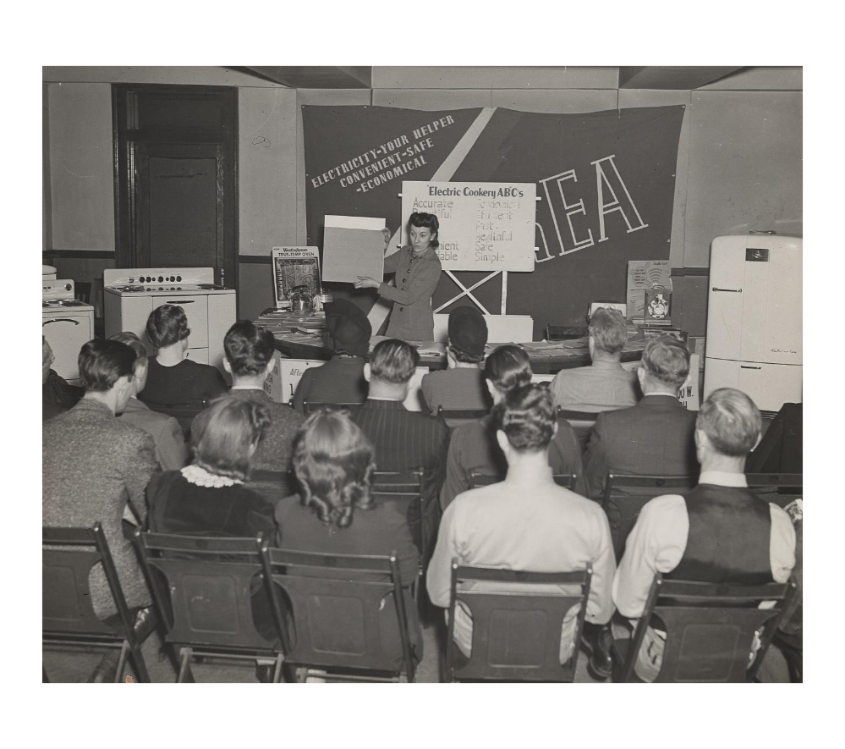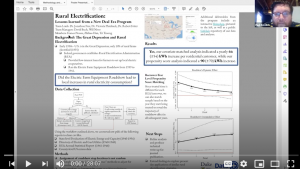Come join the Electric Circus!

In 1935, only 10% of farms in the U.S. were electrified. This was seen as a huge problem – the productivity and quality of life that electricity could bring was bypassing the American farmer. In order to bring light to the countryside, the Rural Electrification Administration (REA) was created to organize farmers, give loans to build new cooperative utilities, and provide information about electricity and its uses.
The trouble was that initial capital costs were high and rural farmers had never experienced electricity before. They didn’t have any equipment or appliances to use it – many strung electric lights in their homes and called it a day. Without using the electricity, people weren’t able to benefit from the increases in well-being and productivity that electricity services can provide, and the rural cooperatives were unable to pay back their loans.
This is a struggle today in many areas of the world where people are being electrified for the first time – whether through big grid extension projects or through new mini-grids. Without the appliances to use electricity peoples are not able to benefit from them, nor are utility companies able to recoup costs and maintain the quality of the system.
In the US, the Rural Electrification Administration (REA) took decisive action. It set up a division of utilization to increase demand for electricity in cooperatives, which included sharing information with customers, advocating for quality certified products, working with appliance companies (such as General Electric and Westinghouse) to target the rural market, offering financing for appliance purchases, public equipment demonstrations, and much more! All of these activities came together in the giant, traveling roadshows that the REA ran all across the country, which were affectionately nicknamed the Electric Circus.

Division of Work and Industry, National Museum of American History, Smithsonian Institution
There are many lessons that can be learned from the Electric Circus for rural electrification efforts today! This summer, two teams of students and graduate project managers brought those lessons to light through the Duke University Story+ and Data+ Summer Programs, led by Dr Victoria Plutshack, Dr Rob Fetter, and Dr Jonathon Free.
Story+ tells the women’s story of the Electric Circus
Activities during the first version of the Electric Circus – officially named the Electric Farm Equipment Roadshow (1939-1941) – were created to be fun for the whole family! However, women and men were sold different products, using different approaches and different messages.

Louisan E. Mamer Rural Electrification Administration Papers, Archives Center, National Museum of American History, Smithsonian Institution
Using archival materials from the Louisan E. Mamer Rural Electrification Administration Papers, Archives Center, at the Smithsonian’s National Museum of American History, the Story+ team answered the questions: What was the role of women in the EFE roadshow? How were women targeted in marketing materials? And what were the assumptions that the REA made about women on the farm?
What the students found was that home economists, like Lousian Mamer, acted as intermediaries between farm women and the institution of the REA. While their job was to inform consumers and sell the idea of an all-electric lifestyle, they took the concerns of farm households to heart, and made sure that demonstrations were specifically addressing the issues that farm women cared about.
In demonstrations and marketing materials, women were inundated with scientific information about how electricity would maintain the health and safety of the family, improve the cooking experience, and would save time on household chores. It was assumed that women’s primary – or only – domain was the household, despite the evidence that women were also engaged in a range of farm activities. Learn more by reading the full report!
Beauty and Efficiency: The Modern Woman and Household Appliances in the REA Roadshow
Project Manager: Dr. Ashton Merck
Project Team: Maddie Fowler, Abigail Phillips, Grace Sipp
For more about the Story+ program, click here.
Data+ traces the impact of the Electric Circus
But the REA wasn’t selling women electric ranges because it was concerned about the quality of women’s cooking. The aim of the roadshow – and all the activities described above – was to increase electricity consumption in rural cooperatives. The question that was left to the Data+ team was this – did the EFE roadshow actually lead to increases in local consumption?

Changes in consumption in the U.S. from ShinyApp
In order to answer that question, the team first needed to convert 70-year old reports from the REA and the Federal Power Commission into excel-formatted datasets. These reports included consumption rates from 1938-1946 for REA cooperatives. Since we also knew where approximately 60 of the roadshow stops had been, the team was able to use covariate and propensity score matching techniques to test whether cooperatives closer to roadshow stops had increased their consumption more than others.
And the answer was…YES! Their analyses found that cooperatives that were within range of the Electric Circus increased their annual consumption by 64-90 kWh per customer more than those that were too far away to reach it. Learn more by exploring the map, poster and data below!
Explore changes in consumption with the ShinyApp
Read the team’s poster to learn how they did it
Project Managers: David Buch, Will Niver
Project Team: Zhihao Han, Franco Picone, Tri Truong
For more about the Data+ program, click here.
Want to know more?
Interested in hearing more about productive uses of electricity and demand stimulation? Check out other work by the Energy Access Project:
Improving electricity access through minigrids in Africa
Research Agenda on Electricity Access and Productive Use
Profits and Productivity: Stimulating Electricity Demand in Low-Income Settings

